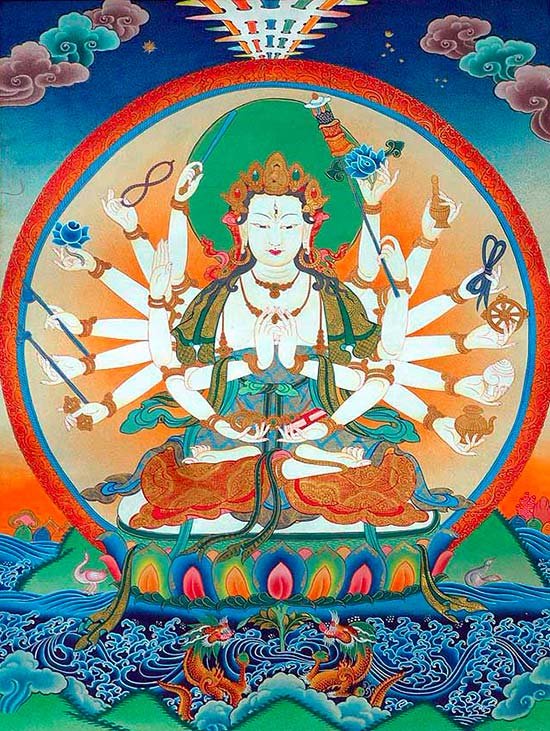Maha Prajnaparamita Sastra
by Gelongma Karma Migme Chödrön | 2001 | 941,039 words
This page describes “buddha’s assistants (upasthayaka)” as written by Nagarjuna in his Maha-prajnaparamita-sastra (lit. “the treatise on the great virtue of wisdom”) in the 2nd century. This book, written in five volumes, represents an encyclopedia on Buddhism as well as a commentary on the Pancavimsatisahasrika Prajnaparamita.
Appendix 7 - The Buddha’s assistants (upasthāyaka)
Note: This appendix is extracted from Chapter XLI part 1 (digression on a case brought against the Buddha):
“But the assistants (upasthāyaka) such as Lo-t’o (Rādha), Mi-hi-kia (Meghika), Siu-na-tch’a-to-lo (Sunakṣetra), Na-k’ie-so-p’o-lo (Nāgasamāla), A-nan (Ānanda), etc., who followed the Buddha, brought him his utensils. Why did the Buddha not have pity on them? ”
Each Buddha had his assistant (upasthāyaka), a monk specially attached to his person, entrusted with fanning him, carrying his robe and bowl for alms-round, introducing visitors. The Sanskrit Mahāvadānasūtra, ed. by S. Waldschmidt, Anhang, p. 172, has drawn up a list of the assistants who served the last seven Buddhas: Aśoka for Vipaśyin, Kṣemakāra for Śikhin, Upaśanta for Viśvabhuj, Bhadrika for Krakasunda (or Krakucchanda), Svastika for Kanakamuni, Sarvamitra for Kāśyapa, and finally Ānanda for Śākyamuni.
We know under what circumstances the last one chose Ānanda: in the twentieth year of his public ministry, the Buddha, feeling old age coming on, felt the need for a servant who would be attached to his residence, and he named Ānanda as his assistant. Having accepted this responsibility, the disciple set certain conditions: never to share the food and robes of the Buddha, not to accompany him among the lay-adepts but to have access to him at any hour of the day (cf. Upasthāyaka-sūtra of the Tchong a han, T 26, k. 8, p. 471c–475a; Mūlasarv. Vinaya, in W. W. Rockhill, Life of the Buddha, p. 88; Fo pao ngen king, T 156, k. 6, p. 155c22–25; Hien yu king, T 202, k. 8, p. 404b–c; Tch’ou tch’ou king, T 730, p. 526a–b; Vinayavinhāṣā, Y 1440, k. 1, p. 504c12–15; Comm. of Anguttara, I, p. 292–296; Comm. of Theragāthā in Psalms of the Brethren, p. 350–352; Sanskrit Mahāparinirvāṇasūtra, p. 192; Sanskrit Mahāvadānasūtra, p. 78; Divyāvadāna, p. 612).
– Ānanda fulfilled his mission with the greatest devotion for the last twenty-five years of the Teacher’s life (Tch’ang a han, T 1, k. 3, p. 19c5; T 5, k. 2, p. 169a15; Traité, above, p. 94F). However, the Northern Mahāparinirvāṇa (T 374, k. 40, p. 601b26) notes only twenty years or more.
Before Ānanda took charge, other disciples functioned temporarily. The Comm. of the Theragāthā (Psalms of the Brethren, p. 350) and that of the Udāna (p. 217) record seven of them and the old canonical sources confirm this:
- Nāgasamāla (cf. Majjhima, I, p. 83, l. 19);
- Nāgita (Dīgha, I, p. 151, l. 8);
- Upavāna (Dīgha, II, p. 139, l. 1; Saṃyutta, I, p. 174, l. 25);
- Sunakkhatta (Jātaka, I, p. 389, l. 16);
- the novice Cunda (Saṃyutta, V, p. 161, l. 23);
- Sāgata (Vinaya, I, p. 179, l. 26):
- Meghiya (Udāna, p. 34, l. 4).
On the other hand, the Vinayamātṛkā of the Haimavatas (T 1463, k. 5, p. 827c12–14) knows of eight disciples who, “fan in hand, fanned the Buddha”.
These were:
- Kāśyapa;
- Hāludāyin;
- Sāgata;
- Meghiya;
- Nāgasamāla;
- Cunda (Mahācunda);
- Sunakṣatra;
- Ānanda.
In the present passage, the Traité mentions, by way of example, only five upasthāyakas, but later (k. 33, p. 303b) it will complete the list:
“When the Buddha Śākyamuni had not yet gone forth (pravrajita), he had Chandaka as assistant (upasthāyaka) and Kāludāyin as playmate (sahakrīḍanaka: cf. Mahāvastu, III, p. 91; Jātaka, I, p. 86); his wives Gopiyā, Yaśodharā, etc., were his close entourage (abhyantaraparivāra).
– Having left home, during the six years of austerity (duṣkaracaryā), he had the group of five [Kauṇḍinya, etc.] as assistants.
– Having once attained enlightenment (abhisaṃbuddha), Meghiyā, Rādha, Sunakṣatra, Ānanda, Guhyaka the Malla, etc., formed his close entourage (abhyanataraparivāra).”
